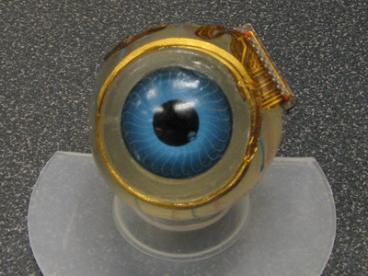Latest MIT retinal implant to see human trials by 2013

Led by an MIT professor, a team with 20 years of retinal implant research announced a prosthesis that could one day help restore a useful level of vision to certain groups of blind people.
The eye implant is designed for people that have lost their vision from one of two leading causes of blindness; retinitis pigmentosa and age-related macular degeneration. The prostheis takes over the function of lost retinal cells by electrically stimulating the nerve cells that normally carry visual input from the retina to the brain.
"Anything that could help them see a little better and let them identify objects and move around a room would be an enormous help," says Shawn Kelly, a researcher in MIT's Research Laboratory for Electronics and member of the Boston Retinal Implant Project, an organization also involved with the research. "If they can recognize faces of people in a room, that brings them into the social environment as opposed to sitting there waiting for someone to talk to them."
The retinal prosthesis works by tricking the brain into seeing by pinging it with electrical signals. Patients with the implant would wear a pair of glasses with a camera that sends images to a microchip attached to the eyeball. The glasses also contain a coil that wirelessly transmits power to receiving coils surrounding the eyeball, according to MIT news.
When the microchip receives visual information, it activates electrodes that stimulate nerve cells in the areas of the retina corresponding to the features of the visual scene. The electrodes directly activate optical nerves that carry signals to the brain, bypassing the damaged layers of retina.
Unlike retinal prostheses being developed by other research groups, the MIT implant is attached to the outside of the eye, and the electrodes are implanted behind the retina. This way, the less invasive surgical procedure and implant won't damage the eye. Another new feature is that the chip is contained in a hermetically sealed titanium case rather than encased in silicone, which would eventually allow water to seep in and damage the circuitry, say the researchers.
The goal of the team is to start testing the new prototype in blind patients within the next three years and to produce a chip that can be implanted for at least 10 years.
